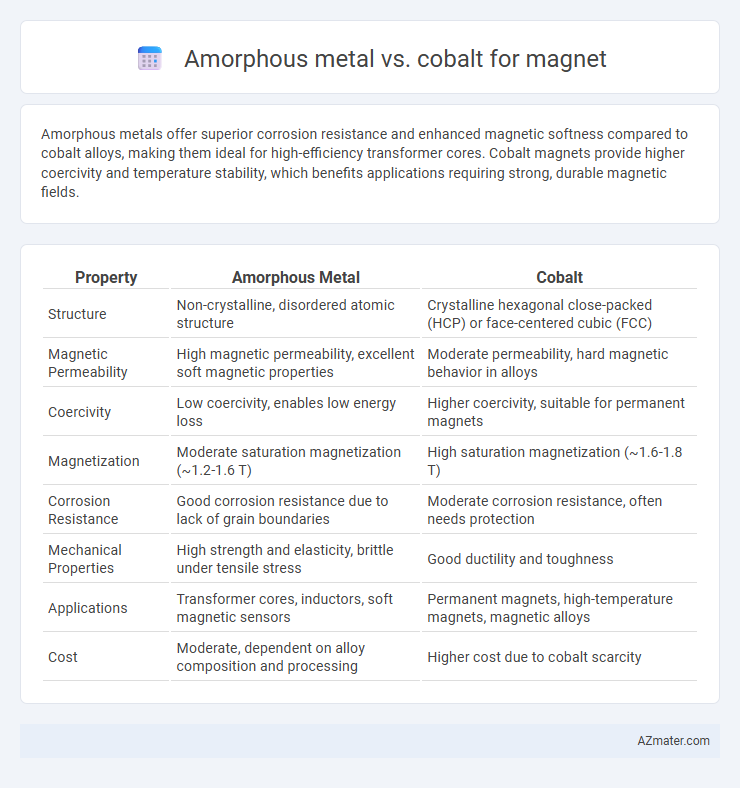Amorphous metals offer superior corrosion resistance and enhanced magnetic softness compared to cobalt alloys, making them ideal for high-efficiency transformer cores. Cobalt magnets provide higher coercivity and temperature stability, which benefits applications requiring strong, durable magnetic fields.
Table of Comparison
| Property | Amorphous Metal | Cobalt |
|---|---|---|
| Structure | Non-crystalline, disordered atomic structure | Crystalline hexagonal close-packed (HCP) or face-centered cubic (FCC) |
| Magnetic Permeability | High magnetic permeability, excellent soft magnetic properties | Moderate permeability, hard magnetic behavior in alloys |
| Coercivity | Low coercivity, enables low energy loss | Higher coercivity, suitable for permanent magnets |
| Magnetization | Moderate saturation magnetization (~1.2-1.6 T) | High saturation magnetization (~1.6-1.8 T) |
| Corrosion Resistance | Good corrosion resistance due to lack of grain boundaries | Moderate corrosion resistance, often needs protection |
| Mechanical Properties | High strength and elasticity, brittle under tensile stress | Good ductility and toughness |
| Applications | Transformer cores, inductors, soft magnetic sensors | Permanent magnets, high-temperature magnets, magnetic alloys |
| Cost | Moderate, dependent on alloy composition and processing | Higher cost due to cobalt scarcity |
Introduction to Magnetic Materials
Amorphous metals exhibit a non-crystalline atomic structure that enhances magnetic softness and reduces energy losses, making them ideal for high-frequency transformers and inductors. Cobalt, a ferromagnetic transition metal, provides high saturation magnetization and excellent thermal stability, which is crucial for permanent magnets and magnetic recording media. Understanding the distinct magnetic properties of amorphous metals versus cobalt is essential for optimizing materials in electromagnetic applications.
Understanding Amorphous Metals
Amorphous metals, also known as metallic glasses, feature a disordered atomic structure that grants superior magnetic properties such as low coercivity, high permeability, and minimal energy loss compared to crystalline cobalt magnets. Unlike cobalt, which has a crystalline structure and offers strong magnetic strength and thermal stability, amorphous metals excel in applications requiring efficient magnetic flux conduction and reduced hysteresis. Understanding amorphous metals involves examining their rapid cooling production process that prevents crystal formation, resulting in unique soft magnetic characteristics ideal for transformer cores and inductors.
Overview of Cobalt-Based Magnets
Cobalt-based magnets, such as Alnico and samarium-cobalt, exhibit high magnetic strength, excellent thermal stability, and corrosion resistance, making them ideal for high-performance applications. Unlike amorphous metals that possess soft magnetic properties with low coercivity and high permeability, cobalt magnets are hard magnets, characterized by strong remanence and high coercivity. The superior magnetic anisotropy of cobalt magnets enables their use in sensors, motors, and aerospace technologies requiring reliable and stable magnetic fields.
Magnetic Properties Comparison
Amorphous metals exhibit superior soft magnetic properties such as high permeability, low coercivity, and minimal core losses compared to cobalt-based magnets, making them ideal for transformer cores and inductors. Cobalt magnets, however, provide higher saturation magnetization and remarkable thermal stability suitable for high-performance, high-temperature permanent magnet applications. The choice between amorphous metals and cobalt depends on balancing magnetic softness for efficient energy transfer against high magnetic strength and temperature resilience.
Electrical Conductivity and Core Losses
Amorphous metal exhibits superior electrical conductivity compared to cobalt alloys, reducing eddy current losses in magnet cores. Its non-crystalline structure results in lower core losses, enhancing magnetic efficiency in high-frequency applications. Cobalt, while offering high saturation magnetization, generally suffers from higher core losses due to increased electrical resistance.
Thermal Stability and Performance
Amorphous metals exhibit superior thermal stability compared to cobalt magnets, maintaining magnetic properties at higher temperatures due to their disordered atomic structure. Cobalt magnets, while strong in magnetic performance, often experience a decline in coercivity and Curie temperature near 500degC, limiting high-temperature applications. The amorphous metal's enhanced thermal stability ensures consistent magnetic performance, making it ideal for environments demanding reliable operation under thermal stress.
Manufacturing Processes and Material Availability
Amorphous metals for magnets are produced through rapid solidification techniques like melt spinning, which creates a non-crystalline structure with superior magnetic softness and corrosion resistance, though the process requires precise cooling rates and specialized equipment. In contrast, cobalt magnets are manufactured via traditional powder metallurgy or casting methods, benefiting from cobalt's abundant industrial availability and ease of forming, but they often face higher raw material costs and limited supply compared to iron-based amorphous alloys. The scalability of amorphous metal production remains challenged by equipment costs and material uniformity, whereas cobalt's established supply chain ensures more consistent material availability for magnet manufacturing.
Cost Analysis: Amorphous Metals vs Cobalt
Amorphous metals generally offer a cost advantage over cobalt for magnets due to lower raw material expenses and simpler manufacturing processes. Cobalt's high market volatility and scarcity significantly drive up production costs, impacting overall magnet price stability. Evaluating lifecycle costs highlights amorphous metals as economically favorable for large-scale or cost-sensitive magnetic applications.
Applications in Modern Industry
Amorphous metal exhibits superior soft magnetic properties, including low coercivity and high permeability, making it ideal for transformers, inductors, and high-efficiency electric motors in modern electronics and energy sectors. Cobalt magnets offer high magnetic strength and excellent temperature stability, essential for applications in aerospace, medical devices, and advanced electric vehicles. The choice between amorphous metal and cobalt magnets depends on specific industry requirements for performance, cost, and thermal resilience.
Future Trends in Magnet Technology
Amorphous metals exhibit superior magnetic softness and higher corrosion resistance compared to traditional cobalt-based magnets, making them promising candidates for next-generation magnetic applications. Emerging trends focus on enhancing energy efficiency and miniaturization in electric motors and generators, where amorphous alloys outperform cobalt in reducing core losses and improving thermal stability. Advances in nanostructuring and additive manufacturing further accelerate the adoption of amorphous metal magnets, positioning them as key materials in the future of sustainable and high-performance magnet technology.

Infographic: Amorphous metal vs Cobalt for Magnet
 azmater.com
azmater.com